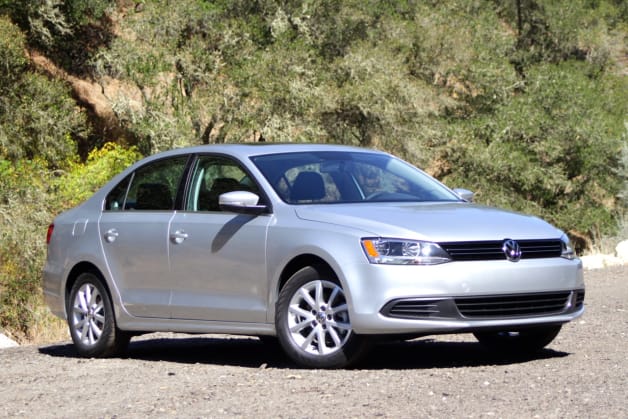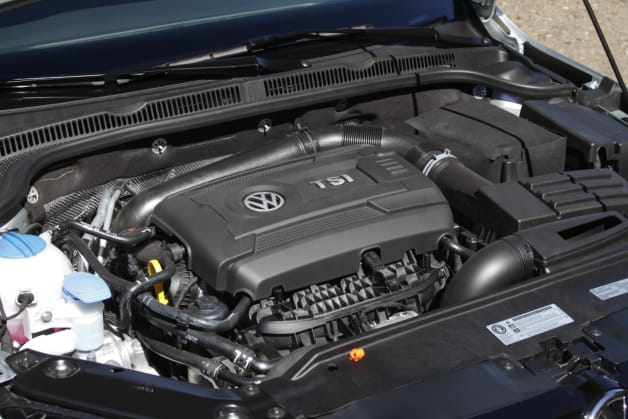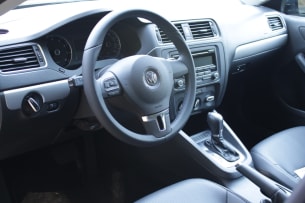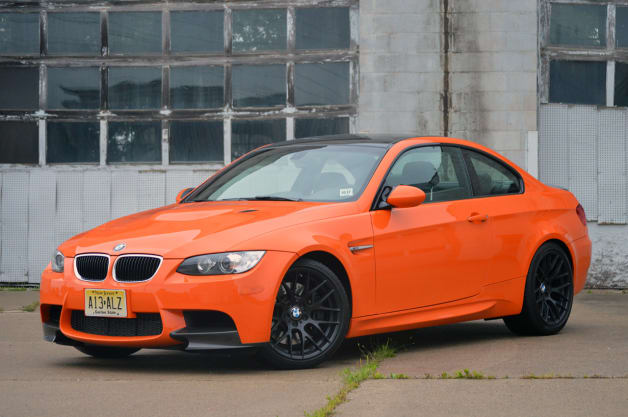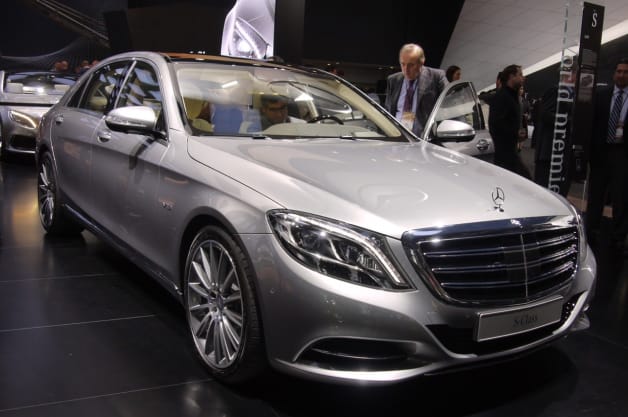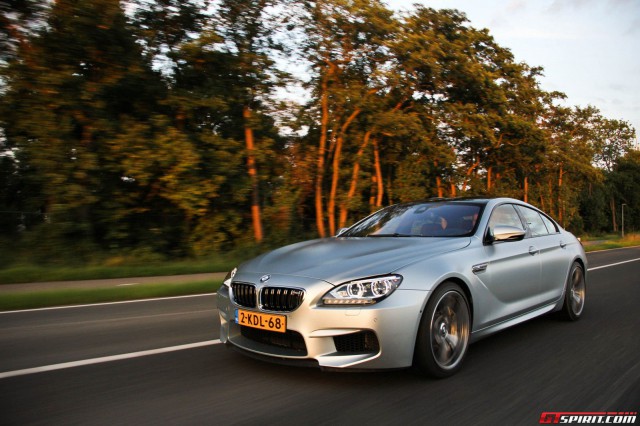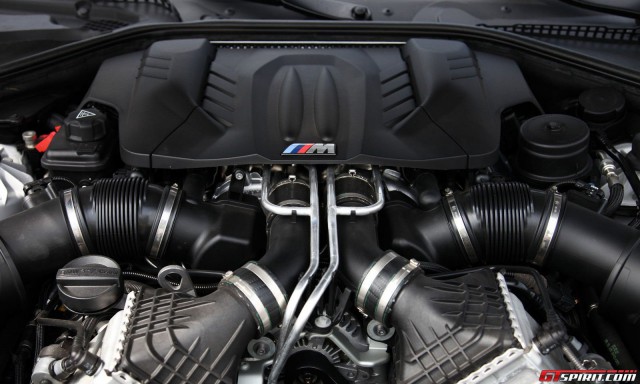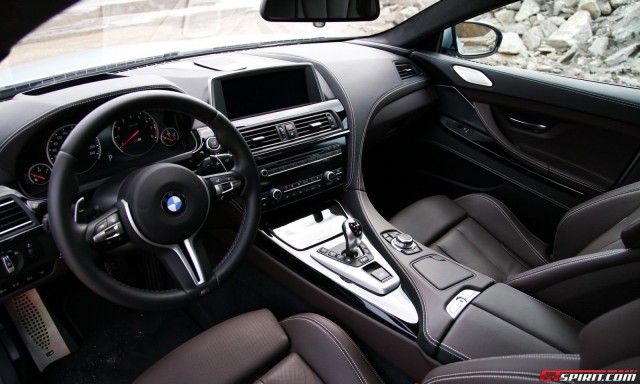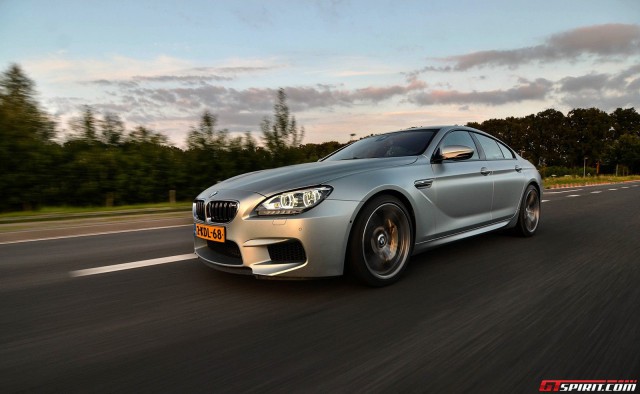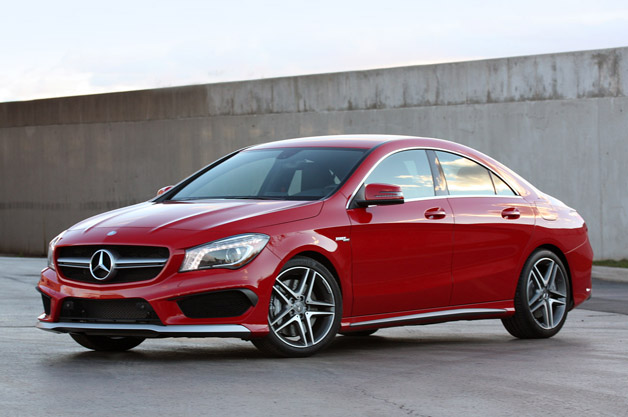
If working from home these past few years has taught me
anything, it's that I genuinely miss commuting. Yeah, you heard me. Maybe it's
because, historically, my commutes have always been pretty enjoyable – not like
the opening scene from Office Space, one of those
stop-and-go-until-the-end-of-time grinds. When I had to drive to an office
every day, I always managed to find routes that didn't involve the highway, or
at the very least, they incorporated a fun on-ramp or two. In my more recent,
working-from-home years, I've made a point of spending my lunch hour on the
road. Not only does doing so allow me to put miles on test cars, it's a nice
break from the nine-to-five – especially when there's a particularly interesting
car in my care.
The 2014 Mercedes-Benz CLA45 AMG arrived late on a Tuesday morning, just before I would normally sign off and take lunch. The CLA has always intrigued me, and to say I've been particularly hot on the 45 AMG would be a gross understatement. So it was with enthusiasm that day that I shut my laptop just as the clock struck noon. There was a CLA45 sitting outside, the keys were in my pocket and I had some time to kill.
Following my quick lunchtime spin, I spent the rest of the afternoon gazing fondly at the CLA sitting outside, its menacing face trying to coerce me to fake some sort of illness ("no, really, I'm soooo sick") and spend the rest of the day flogging it out on the road. The CLA45 is one heck of tempting siren.
The 2014 Mercedes-Benz CLA45 AMG arrived late on a Tuesday morning, just before I would normally sign off and take lunch. The CLA has always intrigued me, and to say I've been particularly hot on the 45 AMG would be a gross understatement. So it was with enthusiasm that day that I shut my laptop just as the clock struck noon. There was a CLA45 sitting outside, the keys were in my pocket and I had some time to kill.
Following my quick lunchtime spin, I spent the rest of the afternoon gazing fondly at the CLA sitting outside, its menacing face trying to coerce me to fake some sort of illness ("no, really, I'm soooo sick") and spend the rest of the day flogging it out on the road. The CLA45 is one heck of tempting siren.
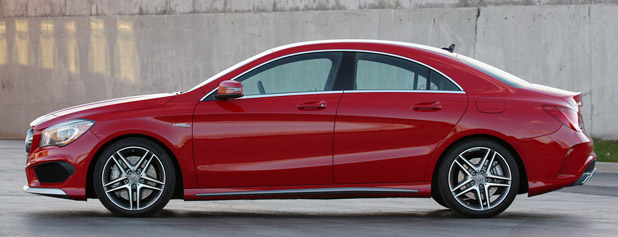
The CLA45 is a pint-sized thing compared to most AMG products.
It's hard not to fall in love with any AMG-badged car, but
know this: the CLA45 will change your entire impression of Merc's performance
arm. The AMGs we've fallen in love with in recent years use rear-wheel drive,
or at least, rear-biased all-wheel-drive systems. These cars are also typically
known for having big, burly V8s under the hood (that 6.2-liter naturally
aspirated eight-cylinder was a particular sweetheart). But the CLA45 changes all
of that. It has all-wheel drive, but it's based on a front-drive platform. And
instead of a monstrous V8, this car uses a 2.0-liter inline four-cylinder
engine with an enormously powerful turbocharger strapped on for good measure.
The CLA45 is a pint-sized thing compared to most AMG products, too. At 184.7 inches long and 70 inches wide, it's roughly the same size as a Chevrolet Cruze, though at 55.7 inches tall, it's 2.4 inches shorter in height. Weighing in at 3,494 pounds, it's about as hefty as a diesel-powered Cruze, too.
But dimensions are only half the story – just look at it. The CLA is a gorgeous, rakish thing and, in fact, Mercedes notes that the standard car's drag coefficient of just 0.23 makes it the slipperiest shape on the road. What's cool about the AMG is that, because the base CLA is already a very aggressive, attractive car, the higher-performance model doesn't look overly bulgy or brash. Not much needed to be added to the original design in order to create the 45. It's all very fluid, with flowing lines, large air intakes, aluminum accents on the lower front fascia and rocker panels and appropriately sized 18-inch wheels wrapped in sticky 235/40R18 tires. For an additional $850, you can even fit 16-spoke, 19-inch alloy wheels finished in either silver or black.
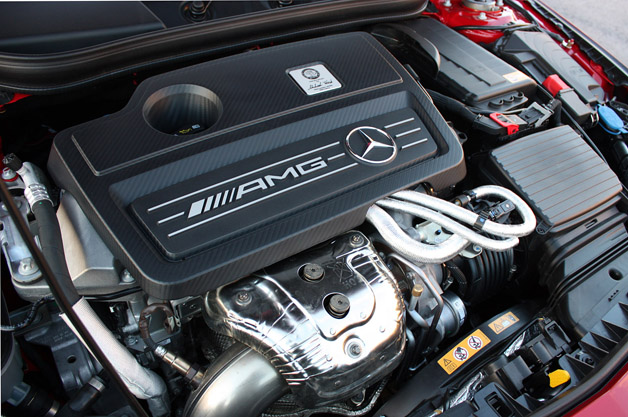
The CLA45 is a pint-sized thing compared to most AMG products, too. At 184.7 inches long and 70 inches wide, it's roughly the same size as a Chevrolet Cruze, though at 55.7 inches tall, it's 2.4 inches shorter in height. Weighing in at 3,494 pounds, it's about as hefty as a diesel-powered Cruze, too.
But dimensions are only half the story – just look at it. The CLA is a gorgeous, rakish thing and, in fact, Mercedes notes that the standard car's drag coefficient of just 0.23 makes it the slipperiest shape on the road. What's cool about the AMG is that, because the base CLA is already a very aggressive, attractive car, the higher-performance model doesn't look overly bulgy or brash. Not much needed to be added to the original design in order to create the 45. It's all very fluid, with flowing lines, large air intakes, aluminum accents on the lower front fascia and rocker panels and appropriately sized 18-inch wheels wrapped in sticky 235/40R18 tires. For an additional $850, you can even fit 16-spoke, 19-inch alloy wheels finished in either silver or black.

The one major downfall to the CLA45 driving experience is a
decidedly unresponsive throttle.
That design isn't for everyone, though. More than a few
people commented on the droopy shape of the taillamps, though I generally find
the rear end design to be rather attractive – big diffuser, side air vents,
quad tailpipes and all. What's more, from the profile, the front and rear
overhangs look a little large, but it's easily forgotten when taking in the
entire shape. Gaze at it from a front three-quarter vantage, and all you'll see
is a svelte sedan that's low and mean. Of course, if the whole sedan shape just
isn't your thing, fly on over to Europe and snag yourself an A45 AMG hatchback.
That car looks still better to my eyes (I'm not alone), and from what European
Editor Matt Davis said in his first drive of the CLA45, the five-door version
is actually more fun to scoot around in, too.
But let's get back to the CLA, and most importantly, what's under the hood. Mercedes claims that the 2.0-liter turbo mill is the most powerful production four-cylinder engine ever made, cranking out a stunning 355 horsepower at 6,000 rpm and an equally important 332 pound-feet of torque between 2,250 and 5,000 rpm. That massive grunt is all thanks to the Honeywell turbocharger, able to put out a whopping 26.1 psi of boost. The AMG isn't incredibly inefficient, either – the EPA estimates the CLA45 will net 23 miles per gallon in the city and 31 mpg highway. Merc fits its little hottie with an automatic stop-start system, to boot. You can turn it off, but honestly, don't worry about it. The system is hardly as bothersome as others I've tested.
This car really is all about the turbo – once you get it going. The one major downfall to the CLA45 driving experience is a decidedly unresponsive throttle, with an oddly huge dead zone upon initial tip-in. The standard CLA suffers from this same strange throttle mapping, likely designed to boost fuel economy ratings. In any case, by the time you've dug deeper into the right pedal, the twin-scroll turbocharger will have spooled up and you'll hit the sweet spot of the torque band. It's just fine from that point onward: power comes on with a great rush, but it's easy to modulate once you finally get used to the action of the throttle. Pro tip: just dig deeper than you'd normally want to. Hell, really stomp the thing.
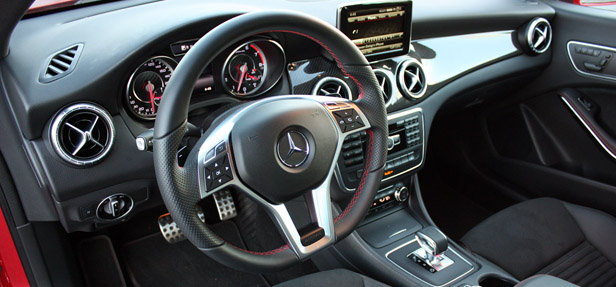
But let's get back to the CLA, and most importantly, what's under the hood. Mercedes claims that the 2.0-liter turbo mill is the most powerful production four-cylinder engine ever made, cranking out a stunning 355 horsepower at 6,000 rpm and an equally important 332 pound-feet of torque between 2,250 and 5,000 rpm. That massive grunt is all thanks to the Honeywell turbocharger, able to put out a whopping 26.1 psi of boost. The AMG isn't incredibly inefficient, either – the EPA estimates the CLA45 will net 23 miles per gallon in the city and 31 mpg highway. Merc fits its little hottie with an automatic stop-start system, to boot. You can turn it off, but honestly, don't worry about it. The system is hardly as bothersome as others I've tested.
This car really is all about the turbo – once you get it going. The one major downfall to the CLA45 driving experience is a decidedly unresponsive throttle, with an oddly huge dead zone upon initial tip-in. The standard CLA suffers from this same strange throttle mapping, likely designed to boost fuel economy ratings. In any case, by the time you've dug deeper into the right pedal, the twin-scroll turbocharger will have spooled up and you'll hit the sweet spot of the torque band. It's just fine from that point onward: power comes on with a great rush, but it's easy to modulate once you finally get used to the action of the throttle. Pro tip: just dig deeper than you'd normally want to. Hell, really stomp the thing.

The tiller's overall demeanour is that of a properly
flickable hot hatch.
Mercedes mates the 2.0-liter engine to its seven-speed AMG
Speedshift dual-clutch transmission, with Efficiency, Sport and Manual modes.
The steering wheel-mounted paddles execute rapid-fire shifts, both up and down,
and they're a joy to use. Left to its own devices, the transmission will
happily hold a gear for long periods of time and will pre-emptively downshift
based on braking. Seriously, though, use the paddles. And when you're really
scooting, you'll hear a chorus of snap-crackle-pop noises from the exhaust and
a little "braap" while shifting. Aural pleasure is a wonderful thing.
Because of the turbo-heavy power delivery, it's rather easy to steer the car with your right foot, especially with the active AMG Performance 4Matic torque-vectoring all-wheel drive and three-stage ESP. You can come into a turn too hot, and when you sense the first tiny bits of understeer, mash the throttle and let the torque do the work. You can almost feel the power running through every part of the car, as the rear wheels grab the road, the back end hunkers down, and any thought of silliness while cornering is avoided. There's a ton of grip available, and it's actually pretty tough to get the CLA to break loose. Oh, sure, you can do it, but it isn't necessary – there's a great deal of fun to be had with the 45's knife-like precision while cornering.
Action through the steering wheel itself is solid, thanks to the speed-dependent, electrically assisted rack. There's a nice on-center weight and plenty of feedback during turn-in, and the tiller's overall demeanour and response is that of a properly flickable hot hatch. It's easy to point the car exactly where you want it, with direct action and solid driver feedback. Braking is also dandy, with secure stopping feel and linear pedal action.
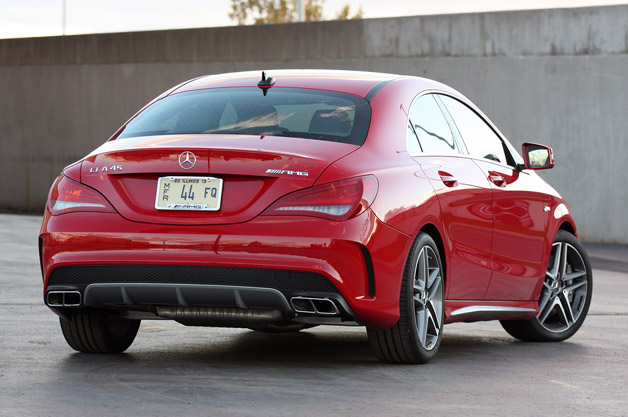
You don't really need the Driver's Pack's increased top speed of 167 miles per hour, do you?
Because of the turbo-heavy power delivery, it's rather easy to steer the car with your right foot, especially with the active AMG Performance 4Matic torque-vectoring all-wheel drive and three-stage ESP. You can come into a turn too hot, and when you sense the first tiny bits of understeer, mash the throttle and let the torque do the work. You can almost feel the power running through every part of the car, as the rear wheels grab the road, the back end hunkers down, and any thought of silliness while cornering is avoided. There's a ton of grip available, and it's actually pretty tough to get the CLA to break loose. Oh, sure, you can do it, but it isn't necessary – there's a great deal of fun to be had with the 45's knife-like precision while cornering.
Action through the steering wheel itself is solid, thanks to the speed-dependent, electrically assisted rack. There's a nice on-center weight and plenty of feedback during turn-in, and the tiller's overall demeanour and response is that of a properly flickable hot hatch. It's easy to point the car exactly where you want it, with direct action and solid driver feedback. Braking is also dandy, with secure stopping feel and linear pedal action.

You don't really need the Driver's Pack's increased top speed of 167 miles per hour, do you?
My lunchtime drive route normally consists of the nearly
empty surface streets and highways that make up downtown Detroit, and if you've
never visited, I promise, there's a ton of fun to be had within the city
limits, especially in a little car like the CLA45. And because you've no doubt
heard about our horrible road conditions here, let me assure you that the CLA's
four-wheel independent suspension does a really fine job of managing pavement
irregularities. Mercedes really does the ride/handling balance better than just
about any other German automaker. This forgiveness might not be as apparent on
cars fitted with the AMG Driver's Package, however – a $1,950 option left off
my test car. Not only do you get the larger 19-inch wheels mentioned earlier,
the AMG Performance Suspension is fitted with front and rear springs that are
20- and 22-percent stiffer than the base setup, respectively. I'm eager to test
this configuration, as it'll no doubt make the CLA a better track attack
missile, but for daily-driving duties, there's nothing wrong with the standard
setup and its 18-inch rolling stock. Leaving this option off keeps the price
down, too. Besides, you don't really need the Driver's Pack's increased top
speed of 167 miles per hour, do you?
Speaking of price, let's address that elephant in the room for a moment. You can tell yourself all day long that the CLA is a sub-$30,000 car, but that's hardly the case with most CLAs, and that's certainlynot the case with the 45 AMG. Pricing starts at $47,450, but can crest $70,000(!) if you tick the right options. Keep a careful watch over your bottom line, and you can end up with a very nicely equipped test car like mine – $53,995 as delivered, including $925 for destination.
Not all of the interior materials are up to snuff – mainly, the plastics found on the doors and dash.
Speaking of price, let's address that elephant in the room for a moment. You can tell yourself all day long that the CLA is a sub-$30,000 car, but that's hardly the case with most CLAs, and that's certainlynot the case with the 45 AMG. Pricing starts at $47,450, but can crest $70,000(!) if you tick the right options. Keep a careful watch over your bottom line, and you can end up with a very nicely equipped test car like mine – $53,995 as delivered, including $925 for destination.
Not all of the interior materials are up to snuff – mainly, the plastics found on the doors and dash.
You have to remember, though, the CLA was sort of designed
from the get-go to be an entry-level car. Because of that, not all of the
interior materials are up to snuff – mainly, the plastics found on the doors
and dash. (Note that, for $1,500, both areas can be improved by adding MB-Tex
trim). Even still, don't write off the CLA's interior just because it's not as
plush as you might expect from a Mercedes. There's other goodness to be had.
The standard front bucket seats are both comfortable and supportive, though Mercedes will happily sell you a set of grippier AMG Performance Seats for $2,250. A variety of leather and MB-Tex seating surfaces are available, and contrasting dash trim can be done up in wood, aluminum or carbon fiber. Not-so-great materials aside, the interior is a nice sight to behold, with a clean center stack and easy-to-use controls. A small rotary knob is found between the front seats to control all of the COMAND infotainment functions, housed in a seven-inch display that comes with the $2,370 Multimedia Package.
Rear seating is – as you would expect – tight, but two adults will fit back there, snuggly. Ingress and egress along with headroom is an issue, though, thanks to that slick roofline. Duck your head and it won't be a problem, but more than one passenger bopped their heads when getting in and out. Trunk space is adequate for a car this size, with 13.1 cubic feet of storage available, and the rear seats fold down for a pass-through into the cabin. It's not nearly as functional as a hatchback, of course, but it's still a welcome dose of utility since we don't get the five-door model.
The standard front bucket seats are both comfortable and supportive, though Mercedes will happily sell you a set of grippier AMG Performance Seats for $2,250. A variety of leather and MB-Tex seating surfaces are available, and contrasting dash trim can be done up in wood, aluminum or carbon fiber. Not-so-great materials aside, the interior is a nice sight to behold, with a clean center stack and easy-to-use controls. A small rotary knob is found between the front seats to control all of the COMAND infotainment functions, housed in a seven-inch display that comes with the $2,370 Multimedia Package.
Rear seating is – as you would expect – tight, but two adults will fit back there, snuggly. Ingress and egress along with headroom is an issue, though, thanks to that slick roofline. Duck your head and it won't be a problem, but more than one passenger bopped their heads when getting in and out. Trunk space is adequate for a car this size, with 13.1 cubic feet of storage available, and the rear seats fold down for a pass-through into the cabin. It's not nearly as functional as a hatchback, of course, but it's still a welcome dose of utility since we don't get the five-door model.
The CLA45 could really be thought of as a sexier, grown-up
Mitsubishi Lancer Evolution
Any interior shortcomings are totally worth the driving fun.
I can fully guarantee that you won't give a flip about sub-par door materials
while you're caning the CLA45 on winding roads. The trick with this car is to
keep the price down when optioning. If you're comfortable walking away with a
sub-$55,000 example, you'll be rewarded handsomely with a car that's impeccable
to drive, drop-dead gorgeous and wears a Three-Pointed Star on the hood for
those of you interested in keeping up with the Joneses.
So often, I talk to other enthusiasts about the CLA45 and the first thing they mention is price. But I'm not convinced that my car's as-tested price of $53,995 is such an absurd amount to pay for what could really be thought of as a sexier, more-powerful, better-driving, better-appointed, grown-up Mitsubishi Lancer Evolution. It'd be the Evo I wouldn't mind commuting in. The Evo I'd want to drive every day.
If the flickable, small-displacement CLA45 points the way forward for AMG, then consider me fully on board. It is, without a doubt, irresistibly good.
So often, I talk to other enthusiasts about the CLA45 and the first thing they mention is price. But I'm not convinced that my car's as-tested price of $53,995 is such an absurd amount to pay for what could really be thought of as a sexier, more-powerful, better-driving, better-appointed, grown-up Mitsubishi Lancer Evolution. It'd be the Evo I wouldn't mind commuting in. The Evo I'd want to drive every day.
If the flickable, small-displacement CLA45 points the way forward for AMG, then consider me fully on board. It is, without a doubt, irresistibly good.
Image Credit: Copyright 2014 Steven J. Ewing / AOL
source: autoblogby Steven Ewing
http://www.boscheuropean.com


